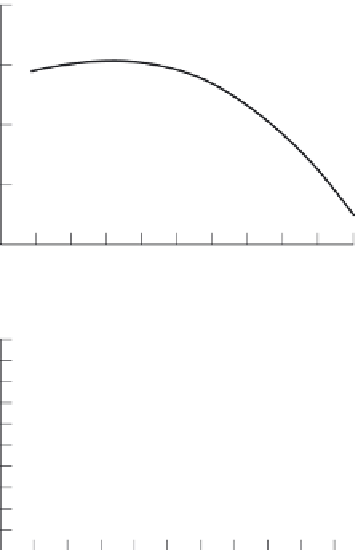Environmental Engineering Reference
In-Depth Information
Fig. 9.11
Relationships
between frequency of
occurrence of the
hemiparasite
Rhinanthus
minor
and (a) mean
sward height (height
achieved by the
grassland community)
and (b) species richness
of plants per experi-
mental plot. The
presence of the
hemiparasite leads to
lower sward height,
because of reduced
success of the parasit-
ized plants, and the
following year to
increased species
richness because of
suppression of
competitive exclusion
by the dominant
species. (After Pywell et
al., 2004.)
(a)
35
30
25
20
15
0
20
40
60
80
100
Frequency of occurrence of
Rhinanthus
per m
2
plot (%)
(b)
10
8
6
4
2
0
0
20
40
60
80
100
Frequency of
Rhinanthus
in previous year (%)
As explained in Box 9.1, there is a critical stoichiometric ratio of carbon : nitrogen
in the soil of 30 : 1 above which bacteria and fungi are nitrogen-limited, and under
these circumstances they withdraw nitrogen from the soil, reducing the concentra-
tion of this critical plant nutrient. Since invasive plants frequently do best when
nitrogen availability is high, you might expect that native species would be favored
if the C : N ratio could be increased from its natural level of about 10 : 1 by the addi-
tion of carbon to the soil. This is precisely what Blumenthal et al. (2003) did in
replicate plots of tallgrass prairie established with 10 weeds and 11 tallgrass prairie
species in Minnesota, USA. Carbon was added to the soil partly as sucrose (to supply
readily available carbon - 5.9% of the mix) and the rest as sawdust (slower for
microorganisms to metabolize). Fourteen levels of carbon addition were performed
in late summer (four replicates of each) ranging from zero to more than 3000 g of
carbon per square meter. As predicted, soil nitrate levels the following year were
negatively related to carbon addition (Figure 9.12a). Weed biomass, in total and for
a number of individual weeds (including
Sinapis arvensis
and
Solanum nigrum
),
declined with carbon addition, no doubt because of reduced nitrate availability
(Figure 9.12b). The opposite pattern was found for total biomass of native prairie
plants (Figure 9.12c) and for a number of individual species (including
Sorghastrum
nutans
and
Monarda fi stulosa
). Carbon addition may be a useful tool for restoring
grassland communities as long as undesirable weeds have high nitrogen demands
and are suppressing less nitrogen-demanding native species.










































































Search WWH ::

Custom Search